Are there alternate tunings?
To me, half the fun of the kalimba is to explore the realms of alternative tunings. If you ever get tired of your kalimba and the things it plays, it is probably time to experiment with an alternative tuning. A good tuning will transform the universe of possibilities open to your kalimba. You can invent your own tuning, but first you should check out the alternative tunings we have documented for each kalimba. And really, there are thousands of good tunings possible for every kalimba, so there is a lot of ground to explore.
While this is not exhaustive, many of the tunings are listed below:
There are many other tunings for the Hugh Tracey Alto Kalimba, but I recommend that you start with the standard G major tuning. Most of the tips, tablature, and books were written for the standard tuning, so a good path to follow is to keep your kalimba in the key of G for a year or two or three as you learn, and then branch out into other tunings as you progress.
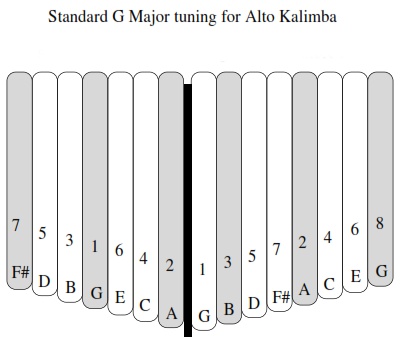
The Hugh Tracey Alto Kalimba’s standard tuning comprises two octaves of the G major scale. The lowest and highest notes are both G, which is the root note, making this tuning easy to understand. Furthermore, there are tons of books and downloads that work with this tuning. The A, Ab, G, F#, F, and E tunings are all basically the same pattern, all with the root note at the bottom and the top notes – hence they can all read the same tablature and use the same books. Why would you want another key other than G? If you don’t know, stick with G tuning.
The letters on the tines in the diagram are the names of the notes each tine is tuned to. The numbers are the degree of the scale – that is, 1, the root note, is “Do” as in “Do, Re Mi, Fa, So”. The number 5? count up, 1, 2, 3, 4, 5, which would be “Do, Re, Mi, Fa, So”. Of course, 8 is the “Do” at the top of the scale, and is the same note name as the bottom “Do” of the scale – that is, 1 and 8 are the same note. The “Do, Re, Mi…” scale is synonymous with the major scale, which is the standard reference for all other scales. Some other scales will have lowered versions of some of the degrees of the scale – a minor 3rd is a lowered, or flattened (taken down a half step) 3rd, and we refer to it as “3-“. Some scales have raised or sharpened (raised a half step) versions of some of these notes, and we indicate them with a plus sign, as in “4+”. And some scales will completely skip some degrees of the scale – the major pentatonic scale skips the 4 and the 7. Stick around, and you’ll learn a lot about music through the little kalimba.
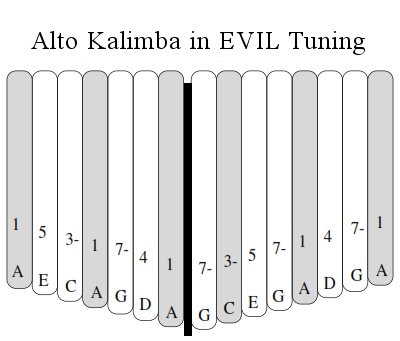
Maurice White of Earth, Wind, and Fire used a 17-Note Treble Hugh Tracey kalimba tuned to an A minor pentatonic scale with redundant notes, wowing people on songs such as Evil and Kalimba Story during the 1970s. The tuning on our Evil Alto kalimba is analogous to the tuning of Maurice White’s Treble kalimba.
In the tablature diagram, the painted tines in the middle of the left side and the middle of the right side are both tuned to A notes, and the next lower tines on both sides are tuned to G notes. This novel tuning permitted Maurice to perform a fast trill on either of those notes by alternating quickly between the left and right versions of either the A or the G, twice as fast as you could trill any single note played on just one side.
The lowest note is the “7-” or flat 7, also known as a minor 7, and it leads into the root note, A = 1. Other notable features are the minor 3rd or “3-“, and the missing 2 and 6, and the root note A at both the top right and the top left.
This type of scale came out of the work of Chicago jazz musician Phil Cohran, who employed an electric kalimba with a similar tuning when he recorded with Sun Ra in the 1960s. Part of the draw of this scale is its distinct African “feel” – one of Hugh Tracey’s research findings was that about 40% of traditional African kalimba tunings use a pentatonic scale like this one. Phil Cohran inspired Maurice White with his use of the kalimba as a symbol of Africa, the pentatonic scale to represent African music, as well as his use of those redundant notes in building musical excitement.
Coming soon: Evil Alto Sound Recording
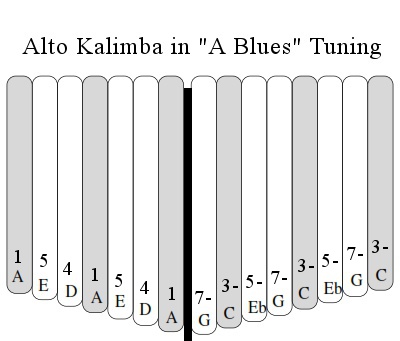
There are actually several “blues scales”. I’ve known about this type of blues scale for 40 years. It is almost exactly the same as the minor pentatonic scale, and it would go great with the Maurice White Evil Tuning. It has an extra note thrown in, the Eb, between the 4 and the 5 in each octave. You can think of it as a raised 4 or “4+” or as a flat 5 or “5-“. In contrast to the Evil tuning, this one does not have any redundant notes. In this tuning a C is added at the very top, with two “5-” notes, the Eb’s that are both on the right side. In the language of the blues, the “5-” note is also called the “blue note”; in the classical world, the “tritone”; in medieval times it was called the “devil’s interval” and its use was forbidden by the Church!
This is not the same tuning Kevin Spears uses, but it is quite similar in nature.
Coming soon: recording of the Alto A minor Blues Tuning.
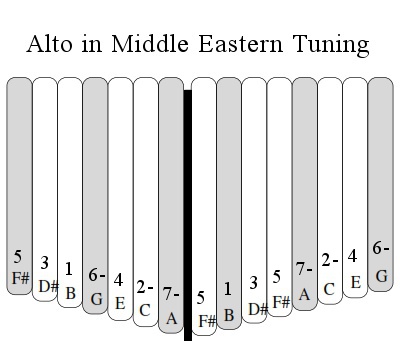 The Middle Eastern tuning was my first alternative tuning, in 2001 of all times.
The Middle Eastern tuning was my first alternative tuning, in 2001 of all times.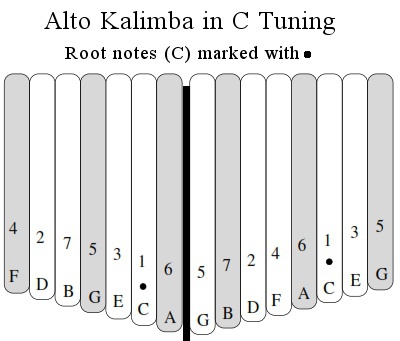
There are two broadly different ways of changing the key of your kalimba. One way is by retuning all the tines in the same way (i.e., pulling out every tine by a half step, which will retune the standard Alto kalimba from G down to F#). The other way is to retune around the
Circle of Fifths – changing just one note per octave will transform both the key and the note layout of the instrument. An example of this is going from the Alto’s standard G tuning to the C tuning shown here. The two F# tines are retuned a half step down to F, and the root note becomes C.
Why would one want to change an Alto kalimba to C from G tuning? Three reasons come to mind: (1) you might need to play kalimba in the key of C to accompany a vocal song for it to be in your vocal range, (2) you can play similar music but in a significantly different range with respect to the root note, enabling you to potentially play a lot of different music and (3) you might need to play in the key of C to play with other musicians – I use my C-tuned Alto to play with my marimba band Baba Marimba.
Here’s the best thing about the C-tuned Alto Kalimba: this is one of the easiest retunings, so you can do it yourself.
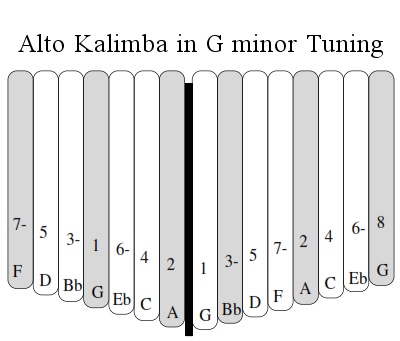
The G minor tuning is conceptually very close to the standard G major tuning. Every note that is present on the standard G Alto is also on this kalimba in the same place with the same letter, but the F# is now F (F also called F natural), the B is now Bb (B flat), and the E is now Eb. (By the way, these are the same basic changes that must occur to turn a G Treble into a Bb Treble.)
It is instructional to compare the G Major tuning with the G minor tuning. The root (1), the 5th, the 2nd, and the 4th, i.e., the most important notes for chord progressions in any particular key, are the same for G minor as for G Major. The G minor tuning has a flat or minor 7th (designated as 7-), a flat or minor 3rd (3-), and a flat or minor 6th (6-). The notes that are changed in this retuning do cause a pronounced change in the emotional flavor of the scale.
Why would you want this tuning? To more completely understand and experience the minor key, with the psychological advantage of having the root note of the minor key in the bass. G minor also goes with Bb major, so this would be a good kalimba to play with the Bb Treble.
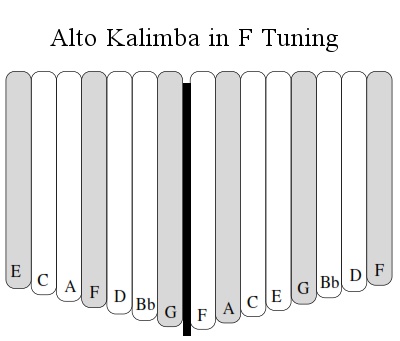 The F tuning is made from the G tuning by simply tuning every note down by a whole step. The role each tine plays in this scale – that is, the 1, the 5, etc., do not change, so anything you learned on the G Alto will be easily played on this tuning, just a step lower. And unless you have perfect pitch, you won’t even realize this instrument is different from the G Alto, since it seems to play just the same as the standard G tuning.
The F tuning is made from the G tuning by simply tuning every note down by a whole step. The role each tine plays in this scale – that is, the 1, the 5, etc., do not change, so anything you learned on the G Alto will be easily played on this tuning, just a step lower. And unless you have perfect pitch, you won’t even realize this instrument is different from the G Alto, since it seems to play just the same as the standard G tuning.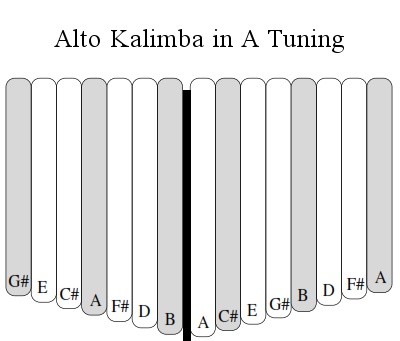
To tune to A major, every tine on a standard-tuned G Alto is pushed in just enough so that the whole instrument rises a whole step in pitch. Just as with the F Alto, unless you have perfect pitch you will not really even realize this kalimba is different from the G-tuned Alto. Every song you play on the standard G Alto can be played on this kalimba, it will just sound a step higher.
In addition to F, G, and A, the Alto kalimba can also be tuned to E, F# (Gb), and G# (Ab). Why don’t more people get their Altos tuned down to E, a great key in which to play along with guitar? The body size of the Alto is designed to resonate down to the low G note, but it starts to lose resonance at F#, more in F, and more still in E. You can compensate for this by playing in a gourd or on a table – a larger resonant structure that will help amplify the lower notes. Playing through a pickup also helps with the reproduction of notes from the low range of the kalimba.
.
If you are undecided about the tuning, your best bet is to go with the standard G major tuning and setup. Most of the tips, tablature, and books were written for the standard tuning, so a good path to follow is to keep your kalimba in the key of G for a year or two or three as you learn, and then branch out into other tunings as you progress. Of course, the
Kalimba Doctor at Kalimba Magic can retune your current treble kalimba any way you like!
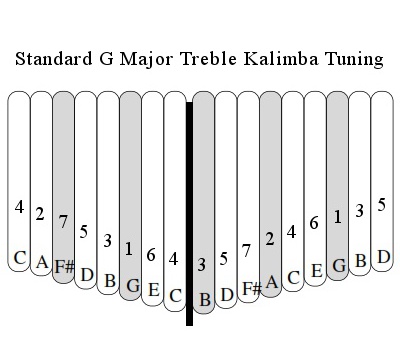
The letters are the names of the notes each tine is tuned to. The numbers are the degree of the scale – that is, 1, the root note, is “Do” as in “Do, Re Mi, Fa, So”. The number 5? Count up, 1, 2, 3, 4, 5, which would be “Do, Re, Mi, Fa, So”. The major scale is the standard reference for all other scales, and scales that have different intervals will indicate their departure from the major scale intervals with a + or – sign, as in 3- for a minor or flattened or lowered third degree of the scale.
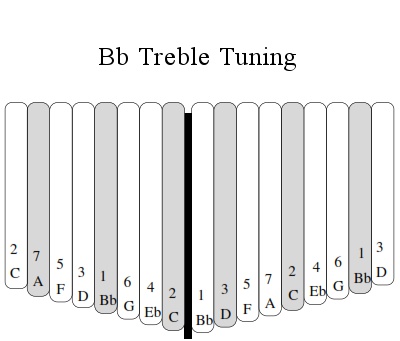 The Bb Treble kalimba reads Alto Tablature – compare the numbers, that is the degrees of the scale, and the painted tines, to the Alto’s standard tuning – they are identical, except for the high 2 and 3 which are missing from the Alto Kalimba’s standard tuning. The notes are all raised a minor 3rd from the Alto standard tuning. All the tines can be pulled out or pushed in a bit and this basic tuning can be extended to the keys of A, Bb, B, or C.
The Bb Treble kalimba reads Alto Tablature – compare the numbers, that is the degrees of the scale, and the painted tines, to the Alto’s standard tuning – they are identical, except for the high 2 and 3 which are missing from the Alto Kalimba’s standard tuning. The notes are all raised a minor 3rd from the Alto standard tuning. All the tines can be pulled out or pushed in a bit and this basic tuning can be extended to the keys of A, Bb, B, or C.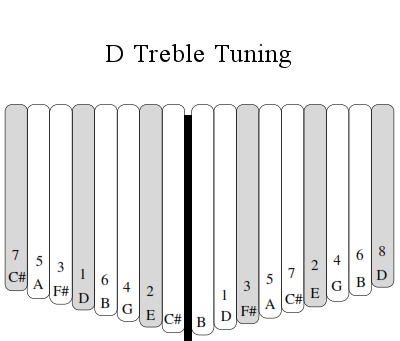 The D Treble kalimba reads Alto Tablature – compare the numbers, that is the degrees of the scale, and the painted tines, to the Alto’s standard tuning – they are identical, except for the two lowest tines B and C# (unnumbered here) which are missing from the Alto Kalimba’s standard tuning. The notes are all raised a 5th above the Alto standard tuning. This basic tuning can be extended to the keys of C, Db, D, Eb, E, and F.
The D Treble kalimba reads Alto Tablature – compare the numbers, that is the degrees of the scale, and the painted tines, to the Alto’s standard tuning – they are identical, except for the two lowest tines B and C# (unnumbered here) which are missing from the Alto Kalimba’s standard tuning. The notes are all raised a 5th above the Alto standard tuning. This basic tuning can be extended to the keys of C, Db, D, Eb, E, and F. This is similar to the tuning that Maurice White of Earth, Wind, and Fire used on essentially all of the kalimba songs they did. I “reverse engineered” it from a YouTube video of Maurice White playing.
This is similar to the tuning that Maurice White of Earth, Wind, and Fire used on essentially all of the kalimba songs they did. I “reverse engineered” it from a YouTube video of Maurice White playing.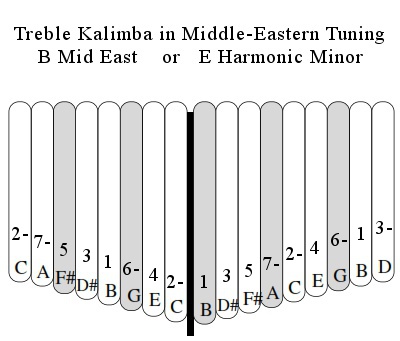 This was my very first alternative tuning, which I made in 2001, and it uses the B as the root for a Middle-Eastern feeling scale. This is a tuning that you can easily do yourself, as all you need to do is push the lower two D tines up to D#. I liked leaving the upper D natural, which can lead to dissonance if you play the octaves – so watch out for that one. This also plays in E harmonic minor. It is actually very fun to switch back and forth between playing in B Middle Eastern and E harmonic minor.
This was my very first alternative tuning, which I made in 2001, and it uses the B as the root for a Middle-Eastern feeling scale. This is a tuning that you can easily do yourself, as all you need to do is push the lower two D tines up to D#. I liked leaving the upper D natural, which can lead to dissonance if you play the octaves – so watch out for that one. This also plays in E harmonic minor. It is actually very fun to switch back and forth between playing in B Middle Eastern and E harmonic minor.
Click on the tuning name to see the tuning and read about it. There are two different tuning setups available for both the Box Alto Chromatic and the Celeste Alto Chromatic Kalimbas: G or C tuning on the front). The Treble Chromatic Kalimba has two different setups: both in C, with or without redundant notes on the back.
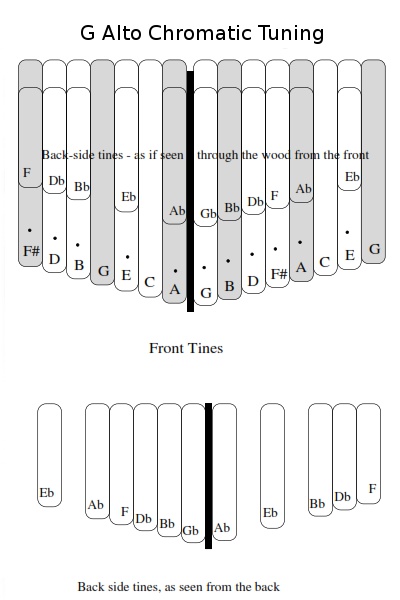
On these chromatic tuning charts, the front tines are the long ones in the top diagram; six are painted (shaded gray). The back-side chromatic tines are represented twice – first, higher up on the upper diagram
the back side tines are displayed as if you could see right through your kalimba . In this view, wherever there is a back-side tine, there is also a dot on the corresponding front tine. The back-side tine is always the flat of the corresponding front-side tine. When you flip the kalimba over and look at the back-side, you will see the mirror image of the previous representation. These are the unpainted tines shown in the lower diagram.
Kalimba Magic recommends that your Chromatic Kalimba be tuned to G on the front, making it just like the Alto kalimba. This means that if you know how to play songs on the Alto Kalimba, you can play all of those songs on the Chromatic’s front, and you can add the chromatic notes on the back at your own pace. It also means that all of the books and educational resources for the Alto kalimba will work for the front side of your Chromatic Kalimba. Plus, since the forthcoming Chromatic Kalimba book will be written for the G Chromatic Kalimba, you will be able to use it.
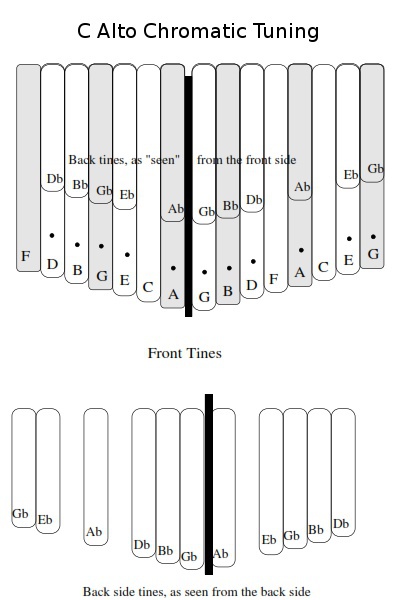
It is possible to retune from G to C (or from C to G). The Chromatic Kalimba in either G or C setup will have all of the chromatic notes over the same two octave range, but some people prefer the C tuning which makes all the front notes be “natural” notes, and all the back-side notes be “flat notes”. (If the Chromatic Kalimba is retuned to C, the front notes are the same as the C-Alto, for which there is an instructional download.)
Retuning from G to C on the front is trivial, only requiring tuning F# to F natural. On the back, most of the tines need to be both rearranged and retuned – the tines need to be taken off the kalimba and reinserted through different slots, as the gaps on the back are positioned in different places in the two tunings. This is difficult but not impossible. If you know from the start that you want your Chromatic Kalimba to be tuned to C on the front, you should order the instrument in the C tuning.
If you already have the Chromatic Kalimba, the
Kalimba
Doctor can take care of retuning for you ($20 covers tuning and domestic US return shipping).
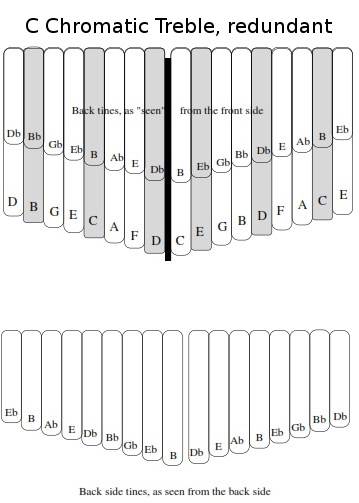
The Chromatic Treble Kalimba has a bass note of C, and the front side is laid out like the Bb Treble, tuned up to C. In its standard tuning, every tine on the front has a flat immediately behind it. That is, there are 17 tines on the front and 17 tines on the back. However, as C flat = B and F flat = E, which are already on the front side, this kalimba has redundant B notes and redundant E notes, one on the front and one on the back. This permits you to trill those notes – playing quickly on the front side and then the back side, etc.
Another way to think of the back side is that it is a full kalimba tuned to B natural… but if you look at it from the back side the notes are reversed left to right. If you could look right through the kalimba, the notes would be oriented the usual way.
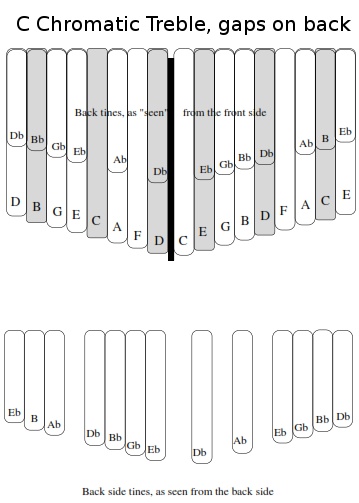
The C Chromatic Treble Kalimba can also be arranged in a non-redundant setup. The gaps between the tines on the back-side really help me find my way on the Chromatic Kalimba, just as the black notes and the gaps between them similarly help a pianist on the keyboard. For this reason, I prefer removing the redundant tines from the back-side of the Chromatic Treble Kalimba, but either setup is available.
We offer the African-tuned Karimba in its standard African tuning plus four westernized tunings:
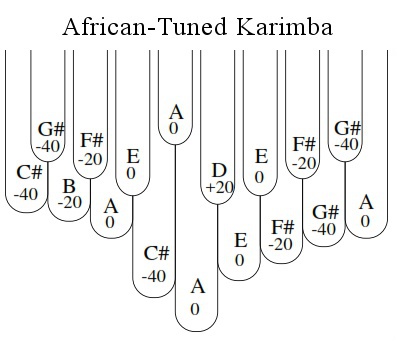
The standard tuning for the traditional, African-tuned karimba is intricate. Use the accompanying chart to tune your instrument. If you have a differently-tuned karimba, you can retune it to the African tuning with this information. And even if you don’t have a karimba, you can learn how a traditional microtonal tuning is set up – it has a logic that is discernable. This is one of the tunings studied by Hugh Tracey as he learned about the detailed tunings of traditional African instruments.
The numbers on the chart are there to help us see, in fine focus, just how sharp or flat the standard tuned notes are. Each number represents how many “cents” sharp (if a positive number) or flat (if negative) that particular tine is, relative to the note name on each tine. A half step is 100 cents. The A’s and E’s are right in tune, while the C# is 40 cents flat, almost halfway between a C and a C#. Why? This is the traditional African tuning that evolved and was perfected in Africa.
The karimba and student karimba books, plus the “10 Traditional Pieces” and “11 Advanced Traditional Pieces” downloads all work with this tuning. They will also work with the A Major or G Major tunings.
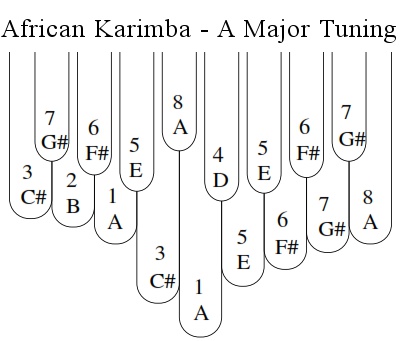
This is the westernized A major tuning for the African Karimba. In this case, the numbers in the diagram refer to the degree of the scale – 1 is the root, 3 is the third, 5 is the fifth, and these notes should all line up perfectly with a properly tuned piano or guitar. Thus you can play this karimba with many western instruments, including guitar and piano. Out of all the westernized karimba tunings, this one is the most useful. Andrew Tracey says that if you put this tuning into the hands of an experienced African player of traditional karimba, they would accept it as more-or-less correct, while they would not accept a minor-tuned version as correct. What this essentially means is that you can play all the traditional songs in this tuning and still get the basic feel of them.
The karimba and student karimba books, plus the “10 Traditional Pieces” and “11 Advanced Traditional Pieces” downloads all work with this tuning.
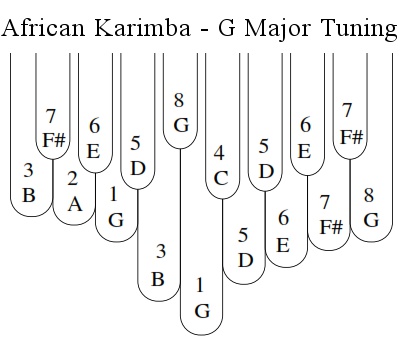
This is the G major westernized tuning of the karimba. This tuning is exactly one whole step down from the A Major tuning. The numbers are all the same, so all the intervals will be the same. Why would you want this instrument in G instead of in A? Because the standard key for Hugh Tracey Alto and Treble kalimbas is G, and if your karimba is also in G then you can play it with the other Hugh Tracey instruments.
The karimba and student karimba books, plus the “10 Traditional Pieces” and “11 Advanced Traditional Pieces” downloads all work with this tuning.
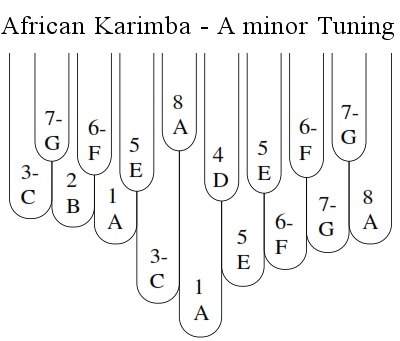
In the accompanying tuning diagram, the minus sign after the 3, 6, and 7 indicate that these intervals are now minor, making it the original African-tuned instrument with its notes rectified down to make an A minor western scale. Why would you want such a tuning? In this tuning, this karimba can produce wonderfully mystical, New Age-sounding music. In addition, it is playable with a Sansula, because A minor is also the standard key for the Sansula. I keep a karimba in this tuning because the A minor tuning has the same notes as the C major scale, and I use it when I perform with my marimba band.
The “Yekermo Sew” and “Three Original Pieces” downloads will work with this tuning.
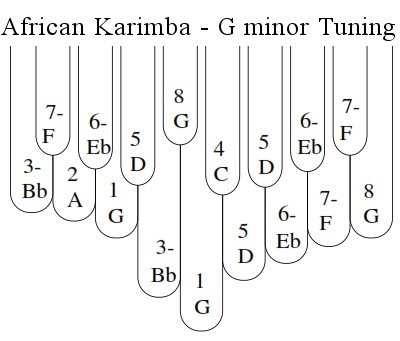
This tuning has the same minor intervals as the A minor tuning, but has been tuned down a whole step.
Why would you want such a tuning? Some people tune their Alto or Pentatonic Kalimbas to G minor because this tuning can lend a more mystical, New Age experience. I use a G minor tuned karimba because it has the same notes as the Bb major scale, so it goes with my Bb Treble.
The “Yekermo Sew” and “Three Original Pieces” downloads will work with this tuning.
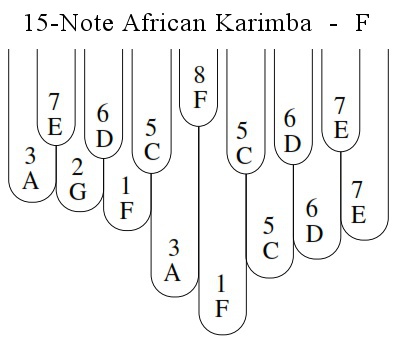 While the 17-Note A-based Karimba is built on a Treble (either celeste or box) platform, it is also possible to build a 15-Note Karimba in F on an Alto platform. F is important and very desirable because of the 55 (minimum) years of history behind the 15-Note F Karimba. In 1960, Andrew Tracey discovered the musician Jega Tapera in the township of Bulawayo, Rhodesia (now the country of Zimbabwe), and he was playing a 13-Note Karimba in F. Jega Tapera was recruited to teach traditional music at the Kwanongoma College of African Music, where students learned on an expanded 15-Note Karimba in F. One of those students was Dumisani Maraire, who brought the 15-Note F Karimba to the USA in 1968, where he popularized it under the name mbira nyunga nyunga (the sparkly, sparkly mbira). Dumisani’s daughter, Chiwoniso, also played the 15-Note F-tuned Karimba.Read more
While the 17-Note A-based Karimba is built on a Treble (either celeste or box) platform, it is also possible to build a 15-Note Karimba in F on an Alto platform. F is important and very desirable because of the 55 (minimum) years of history behind the 15-Note F Karimba. In 1960, Andrew Tracey discovered the musician Jega Tapera in the township of Bulawayo, Rhodesia (now the country of Zimbabwe), and he was playing a 13-Note Karimba in F. Jega Tapera was recruited to teach traditional music at the Kwanongoma College of African Music, where students learned on an expanded 15-Note Karimba in F. One of those students was Dumisani Maraire, who brought the 15-Note F Karimba to the USA in 1968, where he popularized it under the name mbira nyunga nyunga (the sparkly, sparkly mbira). Dumisani’s daughter, Chiwoniso, also played the 15-Note F-tuned Karimba.Read more
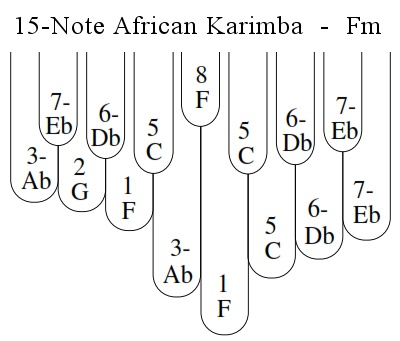 This is the same instrument as the 15-Note F Karimba, but cast into a minor-tuned version.Read more
This is the same instrument as the 15-Note F Karimba, but cast into a minor-tuned version.Read more
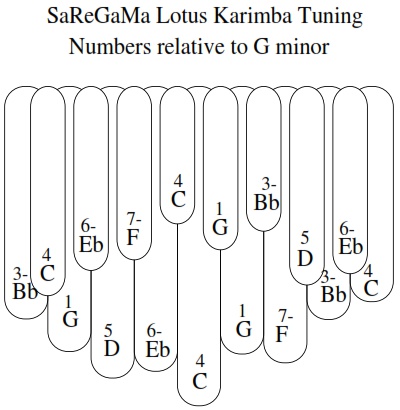 SaReGaMa’s Solo for Lotus is played in G minor, but the tuning supports either G minor or C minor. C minor is in some ways more psychologically compelling because the bass note on the Lotus is C. When G is made to be the root note, this is a straight natural minor scale, except that the 2nd is missing.
SaReGaMa’s Solo for Lotus is played in G minor, but the tuning supports either G minor or C minor. C minor is in some ways more psychologically compelling because the bass note on the Lotus is C. When G is made to be the root note, this is a straight natural minor scale, except that the 2nd is missing.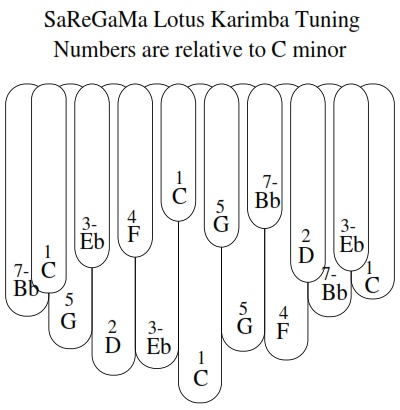 This chart has the exact same note names as the G minor Lotus tuning, but the numbers – that is, the roles that each note is playing – has shifted to make C be the “1” or root. From this point of reference, the 6th is missing, giving this tuning a sort of pentatonic feel. To be completely pentatonic, the D or 2nd would also have to be missing.
This chart has the exact same note names as the G minor Lotus tuning, but the numbers – that is, the roles that each note is playing – has shifted to make C be the “1” or root. From this point of reference, the 6th is missing, giving this tuning a sort of pentatonic feel. To be completely pentatonic, the D or 2nd would also have to be missing.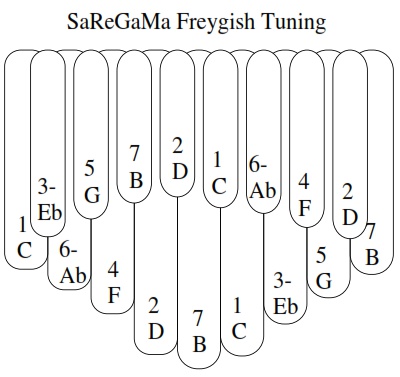 This is a C harmonic minor scale, but it also works as a G Middle Eastern scale. The C natural minor would have a minor 7th, minor 3rd, and minor 6th, but the 7th is a major 7th in the harmonic minor scale.
This is a C harmonic minor scale, but it also works as a G Middle Eastern scale. The C natural minor would have a minor 7th, minor 3rd, and minor 6th, but the 7th is a major 7th in the harmonic minor scale.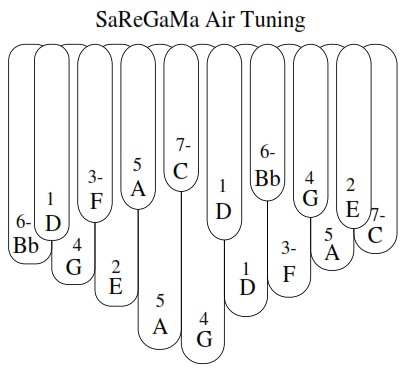 SaReGaMa Air tuning is a form of D minor with a 4 and a 5 in the bass below D (the 1), but skipping the 7th of the scale in the lower range. Why? Avoiding the 7th permits one to hear either an implied major 7th or a minor 7th, so the lower range does not conflict with the harmonic minor (requiring a major 7th). In the upper range, the minor 7th (which is C) is used, making this a natural minor.
SaReGaMa Air tuning is a form of D minor with a 4 and a 5 in the bass below D (the 1), but skipping the 7th of the scale in the lower range. Why? Avoiding the 7th permits one to hear either an implied major 7th or a minor 7th, so the lower range does not conflict with the harmonic minor (requiring a major 7th). In the upper range, the minor 7th (which is C) is used, making this a natural minor.
Originally, every Sansula was tuned to what I now call Standard Tuning, which is mystical, enchanting, beautiful, but ultimately somewhat limiting and even boring. Yes, I admit it – I was bored with this tuning, so I started looking for other ways to tune the Sansula, and those new tunings keep my interest for months to years at a time. When you purchase a Sansula from Kalimba Magic, we will put it into any of these tunings. You may very well be able to change the tuning yourself. And you can always send the instrument to us and we’ll perform the retuning.
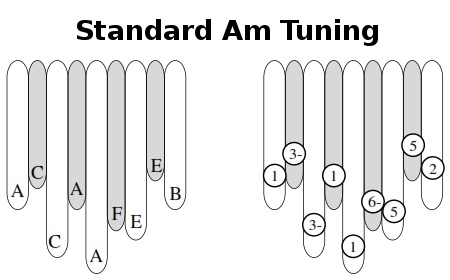
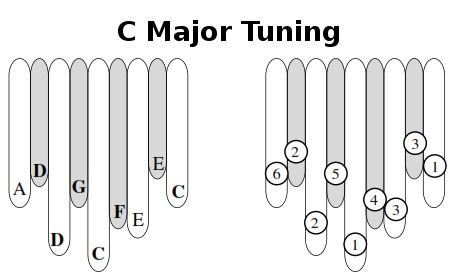
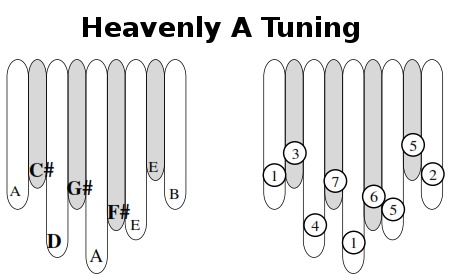
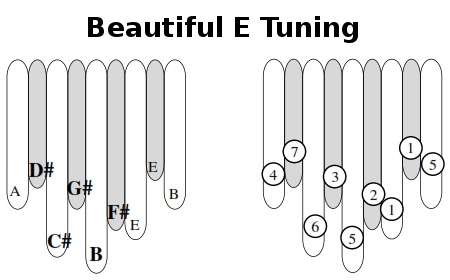
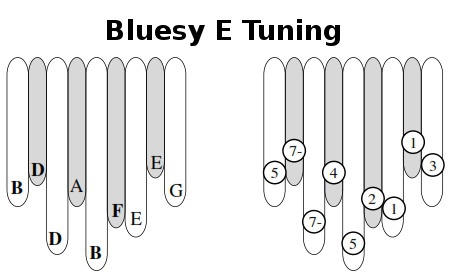
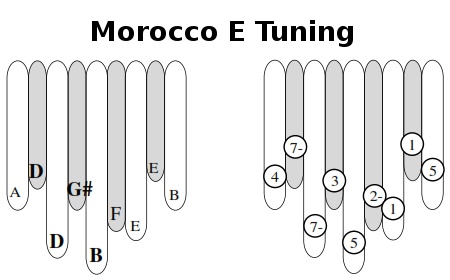
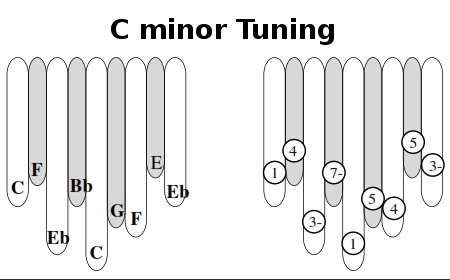
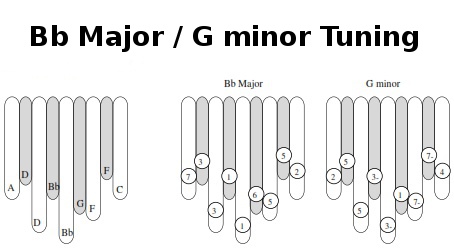
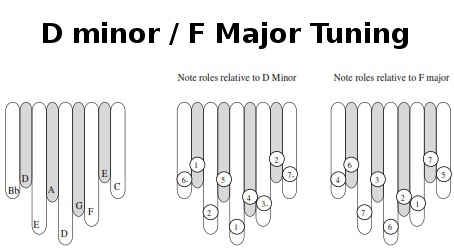
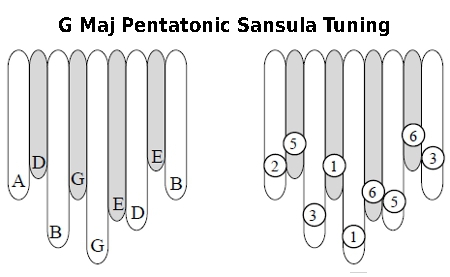
Check it out:
A large part of the purpose of the alternative tunings to other kalimbas is to step out into the world of different possibilities – different sonic universes that can amaze and delight. However, the student karimba is all about being true to this possibly ancient tuning. The different tunings we present for the Student Karimba are all the same basic tuning, but shifted into different keys – there are general reasons to put the student karimba in any of C, F, A, and G, but each of these Student Karimba tunings will be able to play the exact same songs because the relative tuning between the different tines will be the same in all of these tunings.
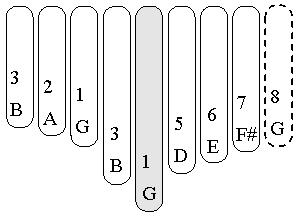 The big Student Karimba Book has recordings in G, while the Student Karimba for Kids has recordings in both G and C. The far right note, 8 = G, is an optional note and is the exact same note as the G tine third from the left.
The big Student Karimba Book has recordings in G, while the Student Karimba for Kids has recordings in both G and C. The far right note, 8 = G, is an optional note and is the exact same note as the G tine third from the left.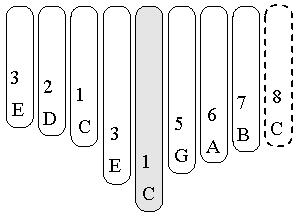 The big Student Karimba Book has recordings in G, while the Student Karimba for Kids has recordings in both G and C. The far right note, 8 = C, is an optional note and is the exact same note as the C tine third from the left.
The big Student Karimba Book has recordings in G, while the Student Karimba for Kids has recordings in both G and C. The far right note, 8 = C, is an optional note and is the exact same note as the C tine third from the left.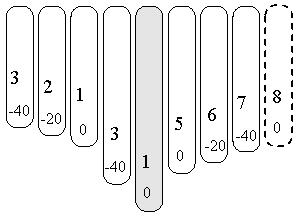
Hugh Tracey demonstrated that traditional African tunings did not use the same system of notes that western music was based on – that is, African music doesn’t exactly fit onto the notes of the piano.
This tuning diagram represents the notes in terms of the degree of the scale (1, 3, 5) and the cents flat that each note should be tuned to. The 0 underneath the 1, 5, and 8 mean these notes should tuned exactly in tune to western notes, while the -20 and -40 indicate that these notes should be tuned 20 or 40 cents flat. There are 100 cents in a half step (that is, the distance between two adjacent notes on a piano).
We usually tune the Student Karimba to be right on the western notes, but you can request an African tuning (in A, G, C, or F), or you can do it yourself.
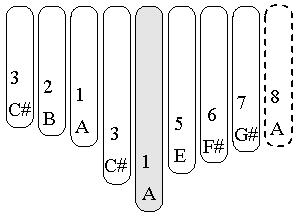 Why would you want a Student Karimba tuned to A? So that you can play it with the 17-Note full African Karimba, which usually comes in the key of A.
Why would you want a Student Karimba tuned to A? So that you can play it with the 17-Note full African Karimba, which usually comes in the key of A.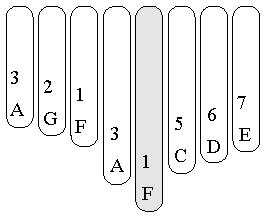 Why would you want a Student Karimba tuned to F? So that you can play it with the 15-Note Karimba in F.
Why would you want a Student Karimba tuned to F? So that you can play it with the 15-Note Karimba in F.
The pentatonic scale is a five tone scale (five notes per octave). There are actually many different pentatonic scales, each with different character, and several of them can be found here.
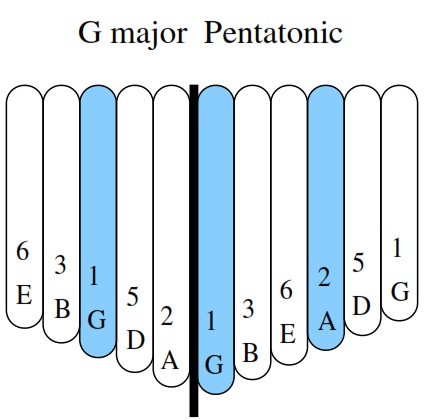
The letters on the tines are the names of the note each tine is tuned to. As G is the root, its role in the music is as the “1”; D is the “5” of the scale. Note that the 4th and 7th are missing. With a little practice, you should be able to see the “1 2 3” and sing “Do Re Mi”… but this tuning skips “Fa” and jumps straight to “So”. By paying attention to the numbers, you can understand how the scale goes and how to use it musically.
The standard tuning of the Hugh Tracey Pentatonic Kalimba is G major.
The Pentatonic Songbook, half of the book
Playing the Pentatonic Kalimba,
and the full numbers-based book 6-Note Pentatonic Kalimba Songbook all will work for this tuning.
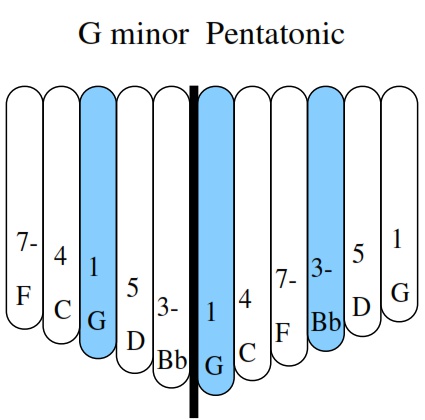
One of the easier and more obvious alternative tunings for your Pentatonic Kalimba, the minor pentatonic scale has recently become popular because of the Native American Flute. It’s a great scale to jam on and you can have plenty of fun without any instructional material, but if you want some guidance, the second half of the book
Playing the Pentatonic Kalimba works for this tuning. This kalimba will work with the Bb Treble Kalimba or any G minor tunings.
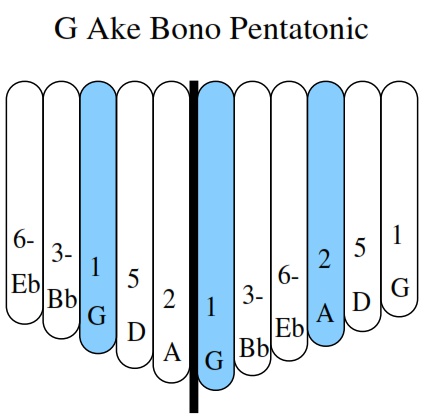 The Ake Bono scale is a Japanese minor pentatonic scale. The song “Sakura” is written in this tuning. The interesting thing that makes this tuning different from the other pentatonic scales that we have discussed is that this scale has two half step intervals (from 2 to 3- and from 5 to 6-) and two intervals that are each two whole steps (3- to 5 and 6- to 1). It is very closely related to the standard G major pentatonic scale – you just tune the B and E down to Bb and Eb. This is a very mystical and beautiful scale.Listen to This Kalimba Tuning
The Ake Bono scale is a Japanese minor pentatonic scale. The song “Sakura” is written in this tuning. The interesting thing that makes this tuning different from the other pentatonic scales that we have discussed is that this scale has two half step intervals (from 2 to 3- and from 5 to 6-) and two intervals that are each two whole steps (3- to 5 and 6- to 1). It is very closely related to the standard G major pentatonic scale – you just tune the B and E down to Bb and Eb. This is a very mystical and beautiful scale.Listen to This Kalimba Tuning
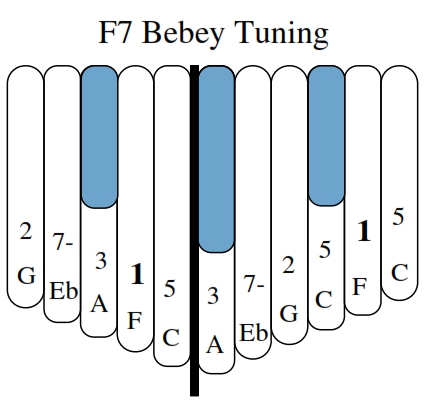
This tuning is found on Cameroonian music legend Francis Bebey’s song “Breaths”. I don’t know anything more about it other than that.
Francis Bebey tended to use a different kalimba tuning for each of his songs. He would lay down a flourish of kalimba notes in an introductory solo, followed by a groove established by the kalimba. The rest of the band – drums, bass, guitar – would then come in on top of the kalimba groove. The kalimba groove would stay constant for the rest of the song.
The musical example of this kalimba uses more of a “solo kalimba” approach throughout the piece.
Listen to This Kalimba Tuning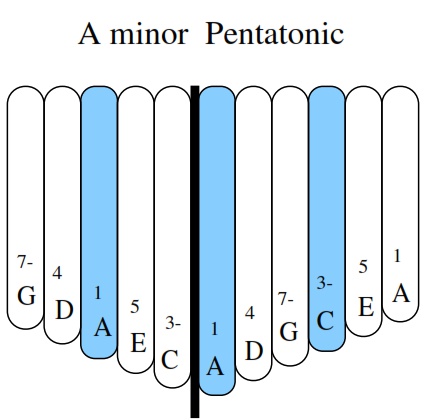 The A minor pentatonic scale has the same degrees of the scale (that is, the numbers) as the G minor pentatonic scale, but it is shifted up a whole note in pitch. As such, it will still work with the second half of the book
The A minor pentatonic scale has the same degrees of the scale (that is, the numbers) as the G minor pentatonic scale, but it is shifted up a whole note in pitch. As such, it will still work with the second half of the book
Playing the Pentatonic Kalimba. This kalimba will work with other kalimbas in G major tuning, other kalimbas in A minor tuning (such as Maurice White’s Evil Tuning on a Treble or Alto), and the standard A minor Sansula tuning.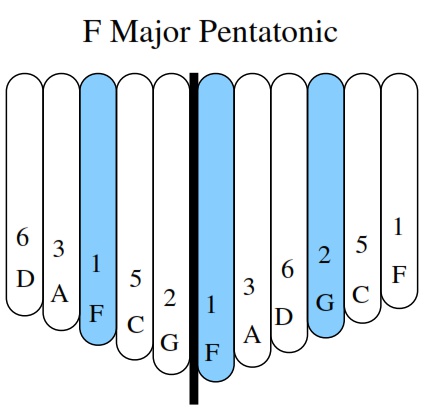 This F Major Pentatonic tuning is just like the standard G Major, but every note has been shifted down by a whole step. All of the relationships between the tines remain the same when retuned in this way. We can actually retune to F, F#, G#, A, or Bb in this manner.
This F Major Pentatonic tuning is just like the standard G Major, but every note has been shifted down by a whole step. All of the relationships between the tines remain the same when retuned in this way. We can actually retune to F, F#, G#, A, or Bb in this manner.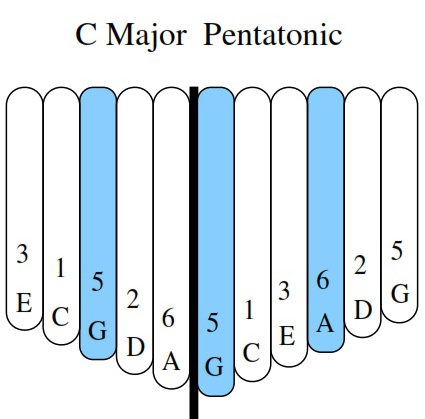 This is very close to the standard G Major Pentatonic tuning – the two B tines have been pushed in a half step to make C, which becomes the root note. Having the 5th in the bass is always a good alternative to having the root note in the bass. This tuning will work with the
This is very close to the standard G Major Pentatonic tuning – the two B tines have been pushed in a half step to make C, which becomes the root note. Having the 5th in the bass is always a good alternative to having the root note in the bass. This tuning will work with the
numbers-based book 6-Note Pentatonic Kalimba Songbook. Of course, this tuning will work well with any of the Catania kalimbas in their standard C tunings, or with any instrument in A minor (such as the Sansula in standard tuning).
The 8-Note Kalimba can be tuned to different scales from around the world.
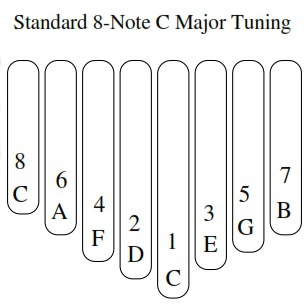 Most 8-Note Kalimbas have a standard tuning of the C major scale (the Goshen Box 8-Note Kalimba has the same basic note layout but is tuned to D major instead). The books assume you have this tuning. While this tuning is totally logical, there are actually a lot of other tunings that you can do wonderful things with.
Most 8-Note Kalimbas have a standard tuning of the C major scale (the Goshen Box 8-Note Kalimba has the same basic note layout but is tuned to D major instead). The books assume you have this tuning. While this tuning is totally logical, there are actually a lot of other tunings that you can do wonderful things with.
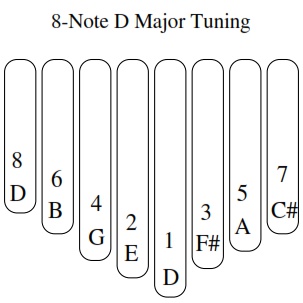 The Goshen 8-Note Box Kalimba has the same basic tuning, except every note is a whole step higher, putting it in D major. You can still use the same 8-Note books, but if you listen to the CD, you cannot play along as it is in a different key.Read more
The Goshen 8-Note Box Kalimba has the same basic tuning, except every note is a whole step higher, putting it in D major. You can still use the same 8-Note books, but if you listen to the CD, you cannot play along as it is in a different key.Read more
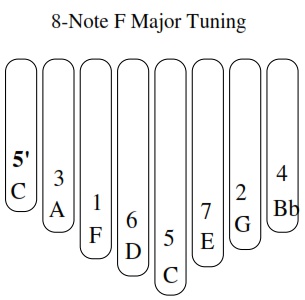
If you compare this tuning chart to the C major tuning, you will notice that the letters are all the same, except that B has turned into Bb (B flat) – that is, you pull it out slightly to make it a bit longer and lower. This action will change it from being the7th of the scale and make it be the 4th… counting down, F is now the root, and the low note (and the top note) on this kalimba, C, is now the 5th.
Why would you want to do this? It turns out that there are a whole bunch of songs you can play on an 8-note kalimba set up like this, and they are not possible in the standard setup. And the best news? This is the smallest possible retuning you can do, and you get a huge result from it! We have a 32 Song download for the 8-Note in this tuning; click the link to purchase the download.
Read more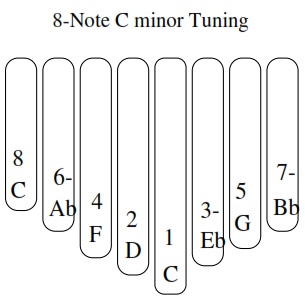 After you pull out your B tine to make it a Bb, you might also consider pulling out the A tine and E tine to Ab and Eb. Why would you do this? These changes will give you a minor 3rd, a minor 6th, and a minor 7th – all the changes you need to accomplish to form the C natural minor tuning. This tuning will be more melancholy, more moody, more mystical. In other words, it will play totally different music, and it is still a very simple retuning, and it is easy to go back to the standard C major. Try it, I think you’ll like it.
After you pull out your B tine to make it a Bb, you might also consider pulling out the A tine and E tine to Ab and Eb. Why would you do this? These changes will give you a minor 3rd, a minor 6th, and a minor 7th – all the changes you need to accomplish to form the C natural minor tuning. This tuning will be more melancholy, more moody, more mystical. In other words, it will play totally different music, and it is still a very simple retuning, and it is easy to go back to the standard C major. Try it, I think you’ll like it.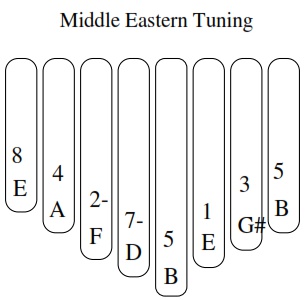 By now you are getting the idea: small changes in the notes you have on your kalimba can make profound changes in the music that comes out of it. The important change in this Middle Eastern tuning is the G going to a G#. Tuning the low C down to a B, and the high C up to an E, are less important changes that serve to reinforce the E as the new root. This tuning will play very cool Middle Eastern sounding music.
By now you are getting the idea: small changes in the notes you have on your kalimba can make profound changes in the music that comes out of it. The important change in this Middle Eastern tuning is the G going to a G#. Tuning the low C down to a B, and the high C up to an E, are less important changes that serve to reinforce the E as the new root. This tuning will play very cool Middle Eastern sounding music.
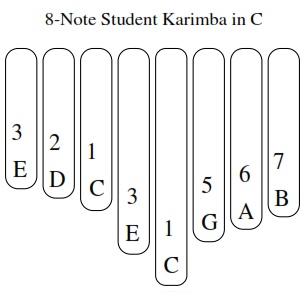 This is perhaps the most important alternative tuning – it reproduces the African Tuned Karimba, also called the Student Karimba. It is thought to be the original tuning of the African Mbira over 1000 years ago, and is thought to be the tuning that Father Do Santos saw when he first wrote about the kalimba in 1586 in present-day Mozambique. Also, you can find a lot of instructional material on this tuning in the Student Karimba section by clicking below.Read more
This is perhaps the most important alternative tuning – it reproduces the African Tuned Karimba, also called the Student Karimba. It is thought to be the original tuning of the African Mbira over 1000 years ago, and is thought to be the tuning that Father Do Santos saw when he first wrote about the kalimba in 1586 in present-day Mozambique. Also, you can find a lot of instructional material on this tuning in the Student Karimba section by clicking below.Read more
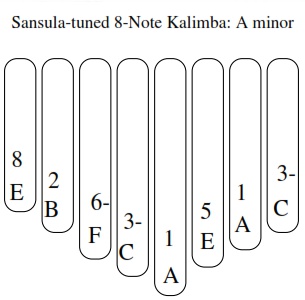 The Sansula is one of the coolest kalimbas in the world, and costs a lot of money too – but the good news is that you can put the Sansula tuning on your inexpensive 8-Note Kalimba. This tuning is an A minor derived from the Ake Bono scale. Learn more about the Sansula by clicking below.Read more
The Sansula is one of the coolest kalimbas in the world, and costs a lot of money too – but the good news is that you can put the Sansula tuning on your inexpensive 8-Note Kalimba. This tuning is an A minor derived from the Ake Bono scale. Learn more about the Sansula by clicking below.Read more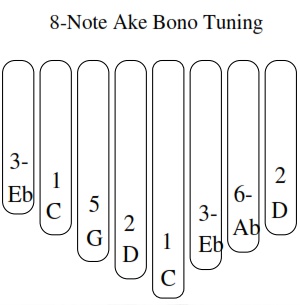 The Sansula tuning is based on the Japanese Ake Bono scale, but it skips a note. Here we have reproduced the C minor Ake Bono scale, without skipping any notes. This is a great scale, and playing it can transport you to another continent.
The Sansula tuning is based on the Japanese Ake Bono scale, but it skips a note. Here we have reproduced the C minor Ake Bono scale, without skipping any notes. This is a great scale, and playing it can transport you to another continent.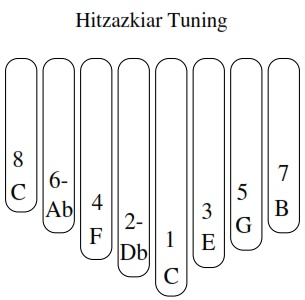 The Hitzazkiar tuning is a Persian scale similar to the Middle Eastern tuning. Look at the right side – C E G B – these are the same notes as the standard tuning, but the notes on the left side are all one half-step above the notes on the right side.
The Hitzazkiar tuning is a Persian scale similar to the Middle Eastern tuning. Look at the right side – C E G B – these are the same notes as the standard tuning, but the notes on the left side are all one half-step above the notes on the right side.
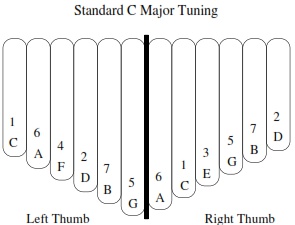
Listen to the 12-Note Kalimba in Standard C Major Tuning.
Almost all of the instructional material is for the Standard C Major Tuning, so if you are in doubt, stick with this tuning.
The kalimba is in C even though G, the 5th of the scale, is the low note.
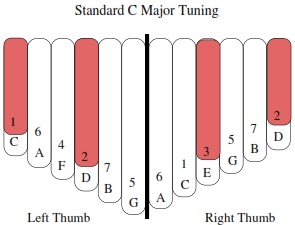
Listen to the standard-tuned 12-Note played with G as the root note – in mixolydian mode.
This is the same Standard C Major Tuning, but this image shows you how your kalimba would look if you request painted tines. The painted E, D, and C match the three painted tines on the 8-Note kalimba, and the 66 Songs Download and the 12-Note Exercises Book work with tines painted this way.
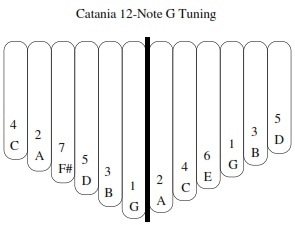
Listen to the 12-Note Kalimba in G Major Tuning.
The G Major tuning is an obvious one to make – just push the F tine in a bit to reach F#, the leading tone, which makes the next note, G, be the root note… which just happens to be the bass (lowest) note already. This is a left handed G tuning though – it can be made right handed, but that requires significant retuning.
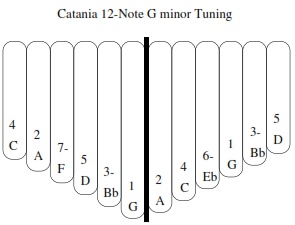
Listen to the 12-Note Kalimba in G minor Tuning.
G minor is a nice tuning – beautiful! Also works as Bb Major.
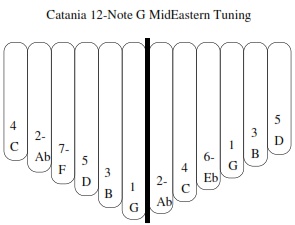
Listen to the 12-Note Kalimba in G Middle Eastern Tuning.
The Middle Eastern tunings always feel exotic. This also works as C harmonic minor, and has the same notes as the SaReGaMa Freygish-tuned Karimba.
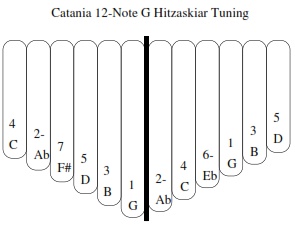
The Hitzaskiar scale is very similar to the Middle Eastern scale, except this one has an F#.
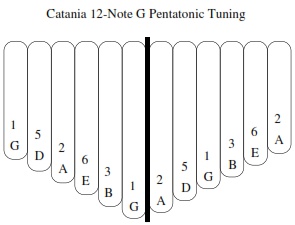
Listen to the 12-Note Kalimba in G Major Pentatonic Tuning.
This pentatonic tuning also works as E minor, and it goes with the Hugh Tracey Kalimbas in their standard G tunings.
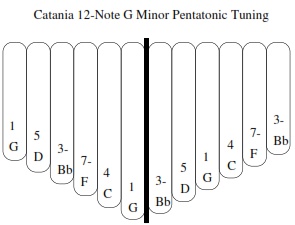
Listen to the 12-Note Kalimba in G minor pentatonic Tuning.
The G minor pentatonic is the “Native American Flute” mode – beautiful and mystical. Works with other G minor kalimba tunings as well as Bb major tunings.
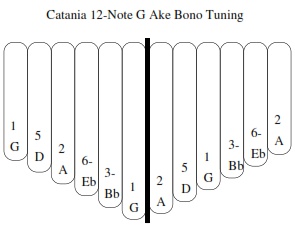
Listen to the 12-Note Kalimba in G minor Ake Bono Tuning.
The Ake Bono scale is a traditional Japanese pentatonic scale, and this tuning can transport you to an ancient temple in a land far away. A favorite tuning.


Sign up for our newsletter and free resources with your email address:
We pinky promise not to spam you and to only send good stuff.
 Christmas in July 2025
Christmas in July 2025 Patriotic and American Music for Kalimba
Patriotic and American Music for Kalimba